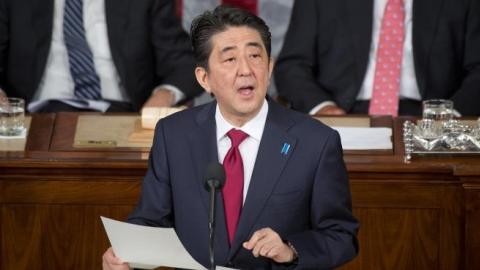So far, it has been a week of solid outcomes in Washington for Japanese Prime Minister Shinzo Abe: a revision of the US-Japan Defense Guidelines for the first time since 1997 to enshrine an expansive role for the Japan Self-Defense Forces, including offering logistical support to the American military around the world; the reiteration on American soil by President Obama that the US security guarantee covers Japan’s administration over the Senkaku Islands; and indications of progress on the Trans-Pacific Partnership, which needs full Japanese participation to succeed. It is no surprise that Obama and Abe released a joint statement declaring that these meetings “mark a historic step forward in transforming the US-Japan partnership.” And Abe delivered a historic address to Congress this morning, the first ever by a Japanese leader.
Less reported, but also critical to the purpose of Abe’s visit, will be the four days the prime minister will spend on the West Coast—in Silicon Valley, San Francisco, and Los Angeles. In part, he’s hoping to connect with the huge numbers of Japanese-Americans in California and tell them that “Japan is back.” He’s also looking for “insight” and “inspiration.” As the Japanese leader openly admits, the success of Abenomics depends on domestic reforms designed to enhance productivity and inventiveness, and where better to learn than from the world’s most innovative country? But the California stops are about selling, too. Specifically, Abe wants to rebrand Japan to its own people and the world by showing that his country is not gracefully declining but learning new things and preparing to do whatever it takes to reinvent itself, as America has done numerous times (and the learning includes by the prime minister himself). After all, four days is a long time for a foreign leader to tour America’s West Coast. Abe knows the time will be well spent, since failure to challenge the narrative that economic leadership in Asia is passing from a staid Japan too afraid to change to the more dynamic China will mean that the former will have many friends but few genuine followers.
As things stand, Japan receives far less credit in terms of its economic importance to the region than it deserves—especially compared to China, which receives too much. A lot of attention is focused on booming trade numbers with China to make the case for Chinese economic centrality. In reality, the bulk of such trade, say between China and Southeast Asian nations, is performed by firms that are fully or significantly owned by parent companies in advanced economies. These firms import and export goods between China and the rest of Asia for alteration, improvement, and assembly, with the final product mainly destined for advanced economies in Asia, North America, and Europe. In fact, Japanese consumers continue to have far deeper pockets than their Chinese counterparts, despite China being seen as the more exciting growth market—meaning that Japan is still more important than China in sustaining the export-dependent models in the region.
In addition to the importance of rich consumers in advanced economies to the export-manufacturing countries in East Asia, the non-advanced economies, including China’s, need to import foreign capital and innovation to reach their potential. In every regional developing economy of note, Japanese foreign direct investment far exceeds that of China’s when it comes to quantity. In terms of quality, firms from the advanced Japanese economy, such as Mitsubishi and Sony, offer far more technology and know-how transfer to developing Asia than do China’s leading firms. The bottom line is that the capacity of economies such as Malaysia to escape the middle-income trap, and for a number of others such as Indonesia, Vietnam, Burma, and the Philippines to reach middle-income status, is more dependent on Japanese investment and expertise than it is on Chinese counterparts.
Even so, Japan has been poor at selling its contemporary importance to the region, let alone why it remains so in the future. When it comes to owning the future narrative, the image of a declining country is accentuated by the realities of its aging demographics and an economy that has been stagnant for the past two decades. In contrast, a China that is still growing rapidly, albeit from a very low base, has been far more skilled at promoting its future economic standing to neighboring countries. This matters because it is one’s future significance that can be used to extract current concessions from smaller powers.
This is where Abe’s West Coast detour comes in. The prime minister seems determined to alter the impression that Japan is an advanced but inward-looking economy stuck on a predetermined path—fated to repeat the malaise of the last two decades over the two to come. By publicly linking the back end of his American trip to lessons he can take back on entrepreneurialism and creativity, Abe is telling the Japanese people that he is serious about changing his country and disrupting its mind-set, and that Japan will not fade quietly into what he has dismissively termed a “tier two” power. To achieve that, his government is convinced that it must lead Asia in emerging sectors that will be critical to national and economic success, such as advanced technologies in computing, materials, and energy. In other words, Abenomics is not just about increasing the country’s GDP but laying the psychological and material foundations for a future Japanese strategic role in East Asia.
Abe’s ambitions have their detractors. Japan’s regional critics, such as China and South Korea, will claim that Abe is really just rocking the boat for no good purpose. Better to retreat into the background and remind itself of past mistakes from the first half of the previous century.
In contrast, Southeast Asians are quietly cheering on Abe’s Japan, or at least his vision for the country’s future. They know that America is a global power with global responsibilities (and distractions). If there is no credible challenge to the narrative of inevitable Chinese economic dominance in Asia, it is questionable whether the American-led alliance system and order can remain. This uncontested narrative will create pressure on these countries to choose prosperity over freedom and eventually band with China in political and strategic matters, or at least stand aside from the fray. In this context, an innovative, nimble, and dynamic Japan can bring a more favorable balance of economic power and leadership to Asia.
Finally, it appears that Obama has also joined with his Southeast Asian partners to cheer Japan on. China’s economy is slowing and its aura of economic invincibility is fading. If Abe can deliver on the promises implied in his country’s rebranding, the American rebalance to Asia might just work.
















